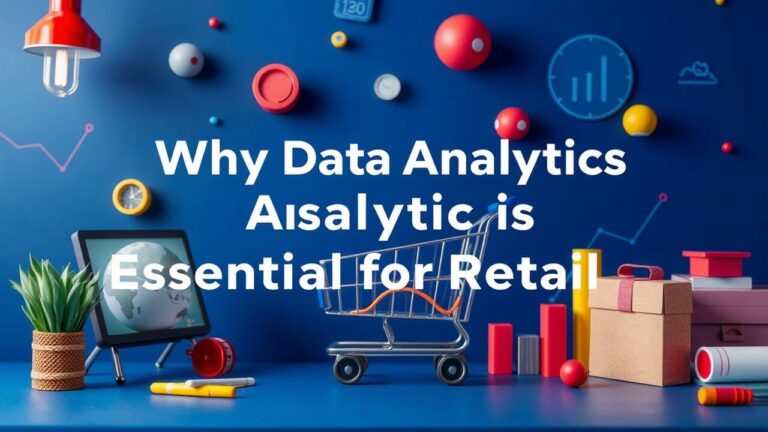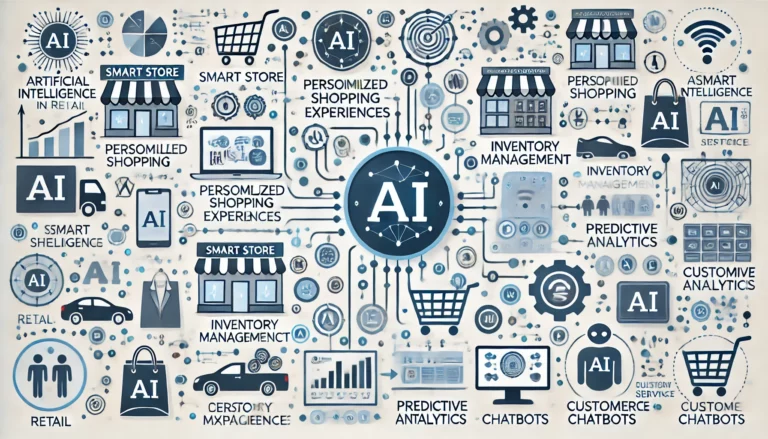Data Analytics in Retail | Transforming Business Insights
Ah, the retail landscape—an intricate web of challenges swirling around data analytics that can stifle the effective harnessing of valuable information. At the core lies a nagging worry: data quality. Picture this—when faced with inaccuracies, incompleteness, or simply outdated information, retailers find themselves teetering on the edge of misguided decisions. And then there’s the labyrinthine task of integrating disparate data sources. Retailers often grapple with piecing together insights from in-store transactions, e-commerce activities, and customer interactions scattered across a myriad of platforms. This fragmentation? It breeds inconsistencies galore and puts up barriers to gleaning actionable insights.
But wait! The plot thickens with another formidable challenge—the relentless pace at which the retail world shifts and sways. Consumer preferences morph faster than one could blink an eye; keeping ahead demands not just quick thinking but also timely analysis steeped in real-time data streams. Add to this cacophony—the staggering volume of generated data—that can easily overwhelm existing systems like a tidal wave crashing onto shorelines unprepared for its force. To navigate these turbulent waters, retailers must pour resources into robust data management solutions designed to streamline operations and amplify efficiency.
Neglecting these hurdles? It’s akin to leaving treasures buried beneath layers of sand—lost opportunities slipping through fingers like grains in an hourglass! Henceforth, it becomes imperative for companies to embrace proactive strategies aimed squarely at bolstering data integrity and accessibility—a quest vital for thriving amidst chaos!
Overcoming Data Quality and Integration Issues
Ah, the tangled web of data quality and integration woes—how it so often thwarts the grand aspirations of retail analytics! Picture this: incomplete datasets lurking in the shadows, ready to skew insights into a misleading fog. To combat these vexing challenges, retailers must rally around sturdy data governance practices that champion accuracy and consistency like knights in shining armor. Regular audits? Absolutely essential! They serve as vigilant sentinels, uncovering discrepancies before they can wreak havoc.
And let’s not overlook the magic of standardized data formats during integration; think of them as universal translators for our disparate systems. This approach elevates compatibility to new heights, paving the way for a far-reaching analysis that truly captures every nuance.
But wait—there’s more! Enter advanced data integration tools—those marvels that take on the Herculean task of merging chaotic datasets into cohesive narratives. With their help, we gain a panoramic view of customer behavior and inventory management that’s nothing short of enlightening. And why stop there? Harnessing artificial intelligence adds another layer—a veritable wizardry—that automates cleansing and validation processes with astonishing efficiency.
Oh, but one mustn’t forget about cultivating a culture steeped in data literacy among team members! Imagine empowering them to navigate the intricate nuances and potential pitfalls within their grasp; such prowess leads to decision-making that’s not just informed but astute—a strategic triumph waiting to unfold!
The Role of Machine Learning in Retail Analytics
Machine learning has utterly transformed the landscape of data analysis for retailers, unlocking a treasure trove of patterns and insights that once seemed elusive, like hidden gems waiting to be discovered. Imagine algorithms—those clever little engines—sifting through mountains of data at lightning speed, revealing customer behaviors with uncanny accuracy. This newfound capability empowers retailers to not only predict what customers might want but also fine-tune inventory management and refine pricing strategies with surgical precision. It’s as if they’ve donned a pair of high-tech glasses that reveal just how products can align perfectly with consumer demand while deftly sidestepping the pitfall of overstock.
But wait, there’s more! The infusion of machine learning into retail isn’t just about crunching numbers; it paves the way for personalized shopping experiences that feel almost magical. Retailers harness predictive analytics like seasoned sorcerers conjuring up recommendations tailored to individual tastes and past purchases. This kind of bespoke experience doesn’t merely elevate customer satisfaction—it supercharges sales by boosting conversion rates in ways previously thought unimaginable. As machine learning technologies continue their relentless march forward, retailers are seizing fresh opportunities to engage their clientele and carve out unique identities in an ever-crowded marketplace.
Automating Insights and Personalization
The infusion of automation into the realm of retail analytics has utterly revolutionized the way businesses collect and decipher data. Picture this: automation tools that slice through mountains of information with surgical precision, enabling retailers to scrutinize vast oceans of data in real time. This newfound prowess empowers organizations to unearth actionable insights at lightning speed—vital for making savvy decisions that elevate customer experiences to new heights! These automated analysis algorithms don’t just process numbers; they trace intricate patterns in customer behavior, spotlighting trends that might otherwise slip under the radar when relying on outdated techniques.
Now, let’s talk about personalization—the secret sauce driving loyalty and satisfaction among customers. By harnessing these automated insights, retailers can sculpt their marketing strategies around individual tastes and buying habits like a skilled artisan molding clay. Machine learning algorithms dive deep into past interactions, paving the way for hyper-relevant product recommendations and pinpointed promotions. This level of bespoke engagement doesn’t merely refine the shopping experience—it supercharges sales! Customers are far more inclined to embrace tailored offers that resonate with them personally. In essence, automation stands as a bedrock upon which an entirely customer-centric shopping landscape is built—a bustling marketplace where each interaction feels uniquely crafted just for you!
Case Studies of Successful Retail Analytics
In the bustling world of retail, successful data analytics implementations often stand as shining beacons of best practices. Take, for instance, a prominent supermarket chain that harnessed the power of advanced data analytics to fine-tune their inventory management like never before. By diving into purchasing patterns and seasonal fluctuations with an eagle eye, this chain dramatically slashed both stockouts and overstocks. The outcome? A delightful uptick in customer satisfaction paired with soaring sales during those frenetic peak shopping times.
Then there’s a striking case from a global fashion retailer—a true game changer! This brand tapped into predictive analytics to elevate the customer experience to dizzying heights. By weaving together intricate threads of customer data, they crafted personalized marketing campaigns and tailored recommendations that resonated deeply with shoppers. The result? An impressive surge in conversion rates coupled with unwavering customer loyalty. Moreover, their adept use of real-time analytics empowered them to pivot swiftly in response to market shifts—an agile maneuver that further cemented their competitive edge amidst fierce industry rivalry.
Real-World Examples and Outcomes
The realm of retail analytics has seen some truly remarkable transformations, yielding not just incremental gains but substantial leaps in operational efficiency and customer engagement. Take, for instance, a leading apparel retailer that mastered the art of data analytics to fine-tune its inventory management dance. By delving into the intricate web of sales patterns and customer preferences, this retailer worked magic on its stock levels—slashing excess inventory by a striking 20% while ensuring that sought-after items were always within reach. This dual victory not only trimmed costs but also elevated customer satisfaction as shoppers found exactly what they craved.
Then there’s the compelling tale of a grocery chain that embraced machine learning algorithms with open arms to supercharge its personalized marketing strategies. Tapping into rich veins of data from loyalty programs and online shopping behaviors, this chain crafted targeted promotions tailored to individual shopping quirks. The outcome? A dazzling 15% uptick in sales stemming from these bespoke campaigns—a clear testament to how data-driven marketing can weave threads of loyalty and propel revenue growth like never before!
Future Trends in Retail Data Analytics
The retail landscape is in the midst of a whirlwind transformation, spurred on by the relentless march of technological advancements. Artificial intelligence and machine learning are not just buzzwords; they’re poised to revolutionize how retailers harness data analytics. Imagine this: retailers are diving headfirst into predictive analytics, skillfully anticipating customer trends and inventory fluctuations with an almost clairvoyant precision. This forward-thinking strategy empowers businesses to make savvy decisions, streamline operations, and fine-tune their supply chain dynamics.
And as retailers pivot towards omnichannel strategies—a necessity in today’s market—the demand for real-time data analysis skyrockets. Customers now crave seamless interactions across a multitude of platforms; thus, the capability to synthesize information from diverse sources instantaneously becomes paramount. Enter enhanced data visualization tools—these sophisticated instruments will help retailers decode intricate datasets with newfound clarity, propelling quicker decision-making processes into play. Meanwhile, personalization isn’t just a trend—it’s an escalating priority. Retailers are increasingly leaning on deep data insights to craft bespoke shopping experiences that resonate deeply with individual needs and preferences, setting the stage for a truly tailored consumer journey.
Innovations Shaping the Retail Landscape
The retail world, oh how it’s shifting and swirling like a kaleidoscope of change, all thanks to the dizzying pace of technological breakthroughs! Picture this: Internet of Things (IoT) devices buzzing away, collecting real-time data from every nook and cranny. This torrent of information empowers retailers to manage their inventories with newfound finesse—no more guessing games about product availability or sales trends; they’ve got eyes everywhere.
And wait, there’s more! Enter augmented reality (AR), that magical realm where customers can see products leap into their living rooms before they even whip out their wallets. It’s not just shopping; it’s an experience that tantalizes the senses!
But hold on tight—the revolution doesn’t stop there! Artificial intelligence (AI) is swooping in like a superhero in a digital cape, transforming retail analytics as we know them. Imagine predictive analytics fueled by AI’s brainpower forecasting consumer whims and shaping pricing strategies with surgical precision. Retailers are harnessing machine learning algorithms to dig deep into purchasing patterns, unveiling bespoke recommendations crafted for each shopper’s unique desires.
These cutting-edge innovations do more than just streamline operations—they weave personalized shopping experiences that wrap around customer loyalty like a warm blanket while propelling revenue growth into new heights. It’s an exhilarating ride through this ever-evolving landscape!
| Innovation | Description | Impact on Retail |
|---|---|---|
| Internet of Things (IoT) | Devices that collect real-time data on inventory and customer behavior. | Improves inventory management and sales forecasting. |
| Augmented Reality (AR) | Technology that enhances the shopping experience by allowing customers to visualize products in their own environment. | Increases customer engagement and satisfaction. |
| Artificial Intelligence (AI) | Machine learning tools that analyze data to predict consumer behavior and trends. | Enables personalized shopping experiences and optimized pricing strategies. |
| Predictive Analytics | Techniques that use historical data to forecast future outcomes. | Enhances decision-making and strategy formulation. |
Best Practices for Retail Data Analytics Implementation
Crafting a robust data governance framework is absolutely pivotal for the successful rollout of retail data analytics. This framework isn’t just a mere suggestion; it must delineate ownership of data, establish stringent quality benchmarks, and set forth compliance protocols that can’t be ignored. Engaging stakeholders from myriad departments ignites a culture steeped in data awareness and accountability—an environment where everyone feels the weight of their role in safeguarding information. Regular training sessions and interactive workshops serve as vital touchpoints, helping employees grasp not only the significance of data security but also mastering the intricate tools used for analytics with finesse. Such foundational efforts do more than bolster data integrity—they weave collaboration throughout the organization’s fabric.
Equally imperative is making integration of all pertinent data sources a top priority. Retailers are often inundated with an eclectic mix of datasets—think sales transactions swirling alongside customer feedback and supply chain metrics dancing together in chaos! By amalgamating this treasure trove into one cohesive analytics platform, businesses unlock an overarching perspective on operations that was previously elusive. The right technological solutions can streamline this integration process while ensuring adaptability to accommodate future growth spurt scenarios. Crafting a nimble analytics strategy empowers retailers to pivot seamlessly amid shifting market dynamics and evolving consumer whims—a necessity in today’s fast-paced landscape!
Strategies for Maximizing Data-Driven Decision Making
In the fast-paced realm of retail, effective decision-making driven by data is not just a luxury; it’s a necessity, and at its core lies a sturdy data governance framework. Picture this: clear roles and responsibilities woven into the fabric of teamwork, creating an environment where data integrity flourishes like wildflowers in spring. Investing in top-notch data management tools isn’t merely beneficial—it’s fundamental! These tools pave the way for consistent data collection processes while establishing standardized methods for dissecting that very data.
But wait—there’s more! Cultivating a culture steeped in data literacy across every nook and cranny of the organization ignites critical engagement with information among employees. This sparks better decision-making that aligns seamlessly with overarching strategic goals.
Now imagine amplifying your capabilities with advanced analytics tools—suddenly, actionable insights emerge from those tangled webs of complex datasets like gems waiting to be uncovered! Retailers must shine a spotlight on predictive analytics to adeptly forecast trends and consumer behaviors. Furthermore, assembling cross-functional teams that meld the magic of data science with everyday business operations can bridge those pesky gaps between insight generation and real-world implementation.
These strategies aren’t just pie-in-the-sky ideas; they create a nimble approach to decision-making—ensuring retailers can pivot swiftly amidst shifting market dynamics, all while keeping their competitive edge razor-sharp!
- Establish a dedicated data governance team to oversee data integrity and usage.
- Provide comprehensive training programs to enhance data literacy among employees.
- Implement standardized procedures for data collection and analysis across departments.
- Utilize advanced analytics tools to identify emerging trends and patterns in consumer behavior.
- Foster collaboration between data science and business operations teams for integrated decision-making.
- Regularly review and refine data management processes to adapt to changing retail landscapes.
- Encourage a culture of experimentation where data-driven insights can be tested and validated in real-time.
Conclusion
The integration of data analytics in retail has skyrocketed to a position of critical importance for businesses eager to elevate customer experience and streamline operations. Retailers tapping into the wellspring of data-driven insights find themselves equipped to make savvy decisions—ones that not only sharpen their competitive edge but also weave personalized shopping adventures for their clientele. As technological advancements unfold like an intricate tapestry, the ability to sift through and analyze colossal datasets will morph, unveiling fresh avenues for innovation and expansion within the sector.
Diving headfirst into best practices for implementing data analytics is crucial for retail operations seeking to unleash the full potential hidden within their data troves. Organizations must place a premium on data quality, funnel resources into robust integration systems, and remain nimble in the face of emerging technologies like machine learning. Cultivating a culture steeped in data-driven decision-making will empower retailers not just to weather challenges but also to seize upon future trends with gusto!






